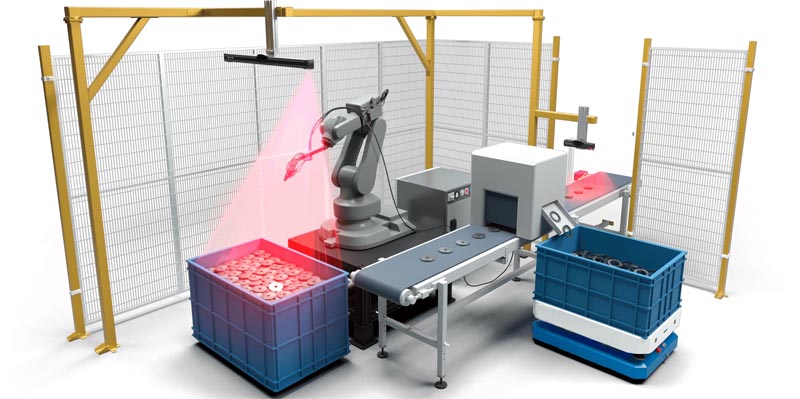
Here is why the 3D vision technology is emerging and showing a growing trend in order to deliver accurate and improve the performance of the applications. There is a rise in the demand for quality products that in turn is encouraging the adoption of 3D machine vision systems. This system is beneficial in keeping up with the need of the customers by assuring automated inspection of the products. The 3D machine vision system finds its application in various industries, from pharmaceuticals to textiles, automotive, consumer electronics, semiconductors, glass, and metals, and various other industries. All these factors are promoting the adoption of 3D vision technology.
3D Machine Vision consists of multiple cameras and laser displacement sensors. Machine Vision systems are coupled with robots that help to locate and to process the operations. 3D Machine Vision requires a digital camera and software for analyzing the image. It ensures processing from all the dimensions. This system comprises a variety of techniques such as stereo vision, 3D triangulation, and, point clouds. Resolution is accountable for differentiating between objects and it improves the efficiency, on the other hand, the sensitivity of the machine means the ability to detect objects or weak impulses in spite of dim lights or invisible wavelengths.
3D Machine Vision is fitted with multiple cameras and it is accompanied by a robotics application that gives part-oriented information to the robots. These cameras are fixed at different positions and the objectives of the camera are set in 3D space. It produces images by surface and volume inspection from all the direction.
A heightmap is produced through the reflected laser displacement. The 3D information of the image is obtained by capturing images from two different viewpoints. Then distance is calculated for the 3D orientation of each viewpoint. A software application is installed, that can process and then analyze images accurately. A PC-based machine vision system is directly connected with vision cameras and image acquisition boards from which an object can be analyzed with machine vision application software.
This component of the machine include cameras, frame grabbers, optics, sensors, and processors. The demand for the camera is very high due to the emerging demand for the complementary metal-oxide-semiconductor (CMOS) imaging sensors. Hardware components play an important role in the efficient working of 3D Machine Vision systems.
In the 3D Machine Vision, the software is installed for analyzing the images captured by the cameras. This software is designed in such a way that it is flexible and easy to handle as well as it should have easy programming for processing of the image. Manufacturing companies also focus on the type of Software while they choose for implantation of the Machine Vision system.
2D- In this type of Machine Vision system, in order to assign the object’s point to capture a 2D image of the object. But it is not considered a good option for the production environment. Due to low cost, it is used commonly in the inspection camera that scans the object and captures screenshots in different resolutions.
3D- It is mainly based on time of flight technique and also on geometric angle based techniques. It includes stereo vision, laser triangulation, light stripe projection, etc. 3D Machine Vision is an advanced technology that even allows the object's movement during the time of recording. 3D Machine Vision is preferred over 2D machine vision due to a large number of advantages accompanied by it.
Since the camera-based or laser-based machine vision system has been recently introduced. And it is considered as more advanced image processing technology. With the advancement of technology, the machine system is becoming more advanced, newly designed smart cameras are designed with open-embedded technology that eliminates the dependency on peripheral devices such as frame-capture or computer.
Manufacturing activities and Industrial production are becoming complicated day-by-day, and growing undependability for the human eye to detect, spot, and examine activities of production thereby increasing the adoption of machine system in manufacturing industries. . Besides, the development of standardized interfaces expands the interoperability between automation technology and machine vision.
The 3D machine vision systems market has been witnessing rapid growth as these systems are able to process a vast amount of information within a matter of seconds. Also, it has rapid processing ability and is helpful for manufacturers to rapidly manufacture products with almost insignificant defects. Machine vision systems are increasingly used for camera surveillance, identifying number plates for security purposes, and also monitoring the traffic.
Post COVID-19 outbreak, it is expected that the manufacturing companies worldwide are now planning to capitalize more on the automation systems for inspection of the product. The extensive adoption of the machine vision system has made it an integral part of the automation inspection system. All these factors are projected to increase the demand for 3D machine vision systems in the coming years. The Global 3D machine vision systems market has been anticipated to rise at a growth rate of 18.3% CAGR over the forecast period.